To keep vessel sinks looking stunning and working well for years, clean and maintain them correctly. These stylish sinks add a modern touch to any bathroom.
However, without proper care, their beauty can fade quickly. Water spots, soap scum, and even cracks can form if not treated. Vessel sinks need extra attention to stay in shape.
This post shares tips that go beyond basic cleaning. These tips help preserve the finish, prevent damage, and extend your sink’s life.
Whether your sink is glass, stone, or ceramic, these simple habits will keep it looking new and performing well in your daily routine.
Regular Cleaning
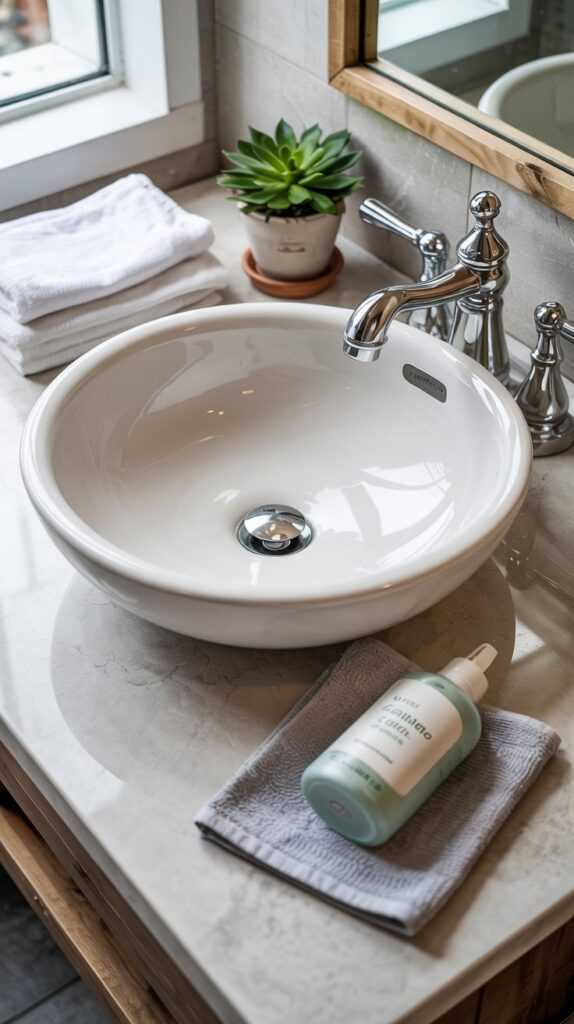
Clean your vessel sink often with a mild cleaner. This removes daily grime and prevents buildup. Regular cleaning keeps your sink shiny and new.
Avoid harsh chemicals and abrasive sponges. They can scratch the surface and ruin the finish. Use gentle cleaning tools and products instead.
Wipe down your sink after each use. This habit prevents water spots and soap scum. Keeping your sink dry makes it easier to maintain over time.
Avoid Harsh Chemicals
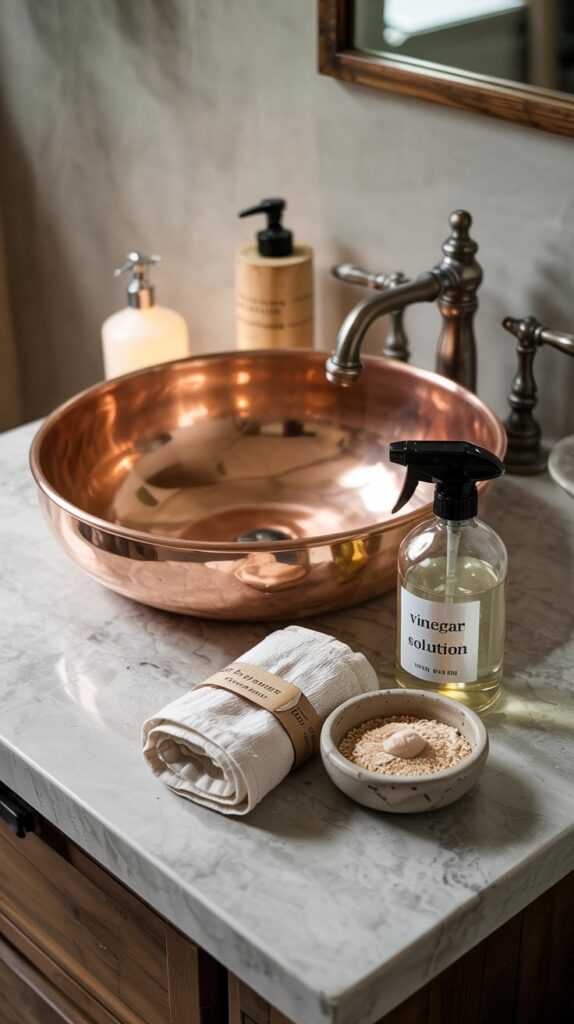
Using gentle cleaners will keep your vessel sink looking new. Harsh chemicals can discolor the surface and wear it down over time.
For cleaning, choose mild soaps and soft sponges. This prevents scratches and keeps the sink smooth and shiny.
Rinse your sink with water after each use. This quick step removes residue and helps prevent buildup and stains, extending the life of your sink.
Here is our recommended Vessel Sink on Amazon
Rinse After Use
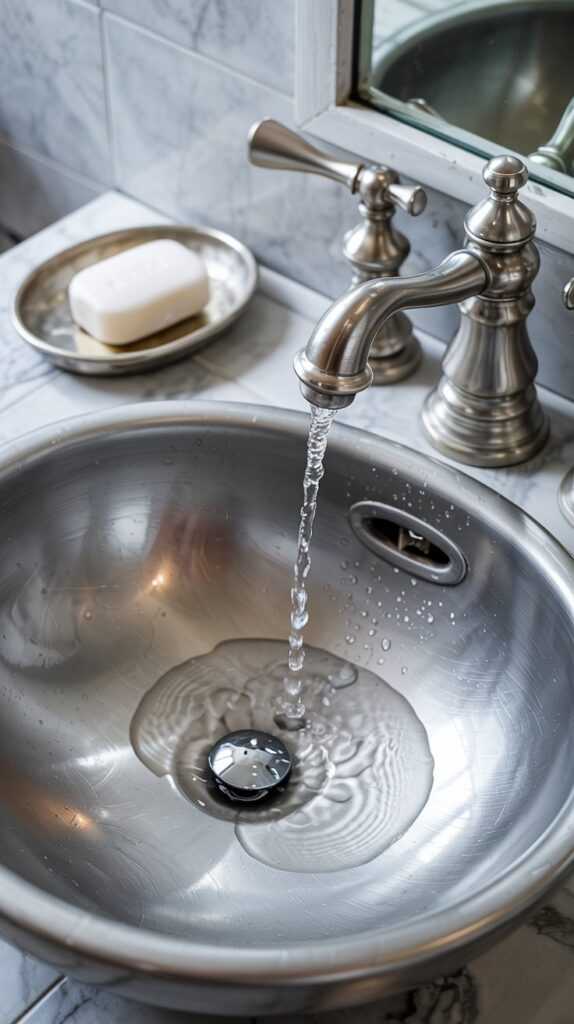
To keep your vessel sink looking great, rinse it with clean water after each use. This simple step prevents soap scum and residue from building up.
Regular rinsing can cut down on stubborn stains and water spots. It helps your sink stay clean and shiny for a longer time.
Rinsing after each use also maintains the surface finish, whether it’s glass, ceramic, or metal. This habit can extend your sink’s life and keep it looking new.
Dry the Sink

After rinsing your vessel sink, dry it with a soft cloth. This helps prevent water spots and mineral build-up. It keeps your sink shiny and new.
Regularly drying the sink keeps it clean and reduces long-term damage from mineral deposits. It’s a quick way to maintain its appearance.
Using a soft cloth ensures you don’t scratch the surface. This simple habit can save you from more intensive cleaning or repairs later. Keep your vessel sink spotless and well-maintained.
Here is our recommended Vessel Sink on Amazon
Use a Protective Mat
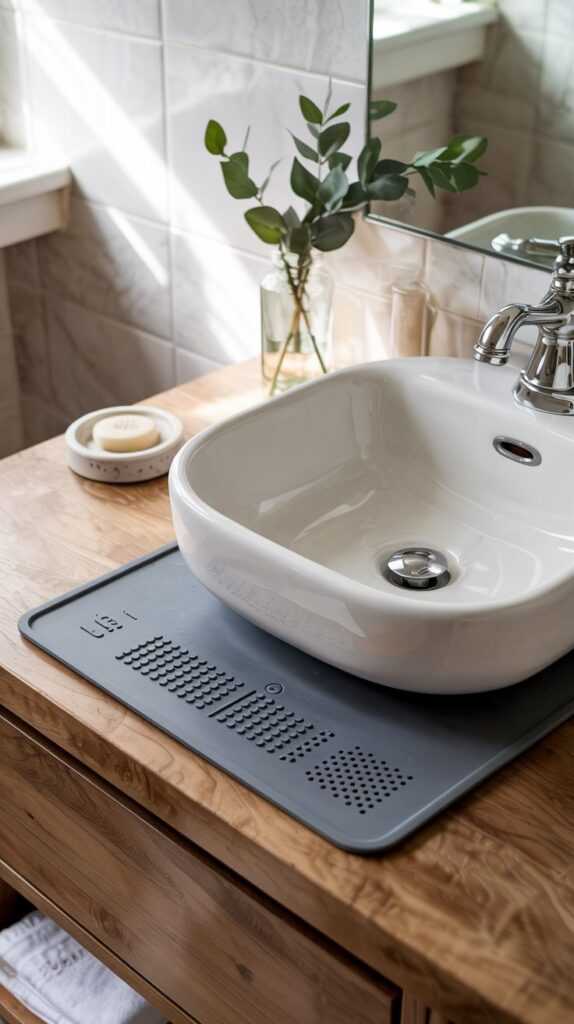
Placing a mat at the bottom of your sink can prevent scratches from utensils. This simple step helps your sink look new longer and cuts down on wear and tear.
A protective mat can also reduce noise when you put dishes and pans in the sink. This makes your kitchen more pleasant by lessening the clatter of metal on metal.
Using a mat not only protects your sink but also keeps your dishes from chipping. The soft surface cushions the impact, protecting both your sink and kitchenware.
Avoid Abrasive Tools
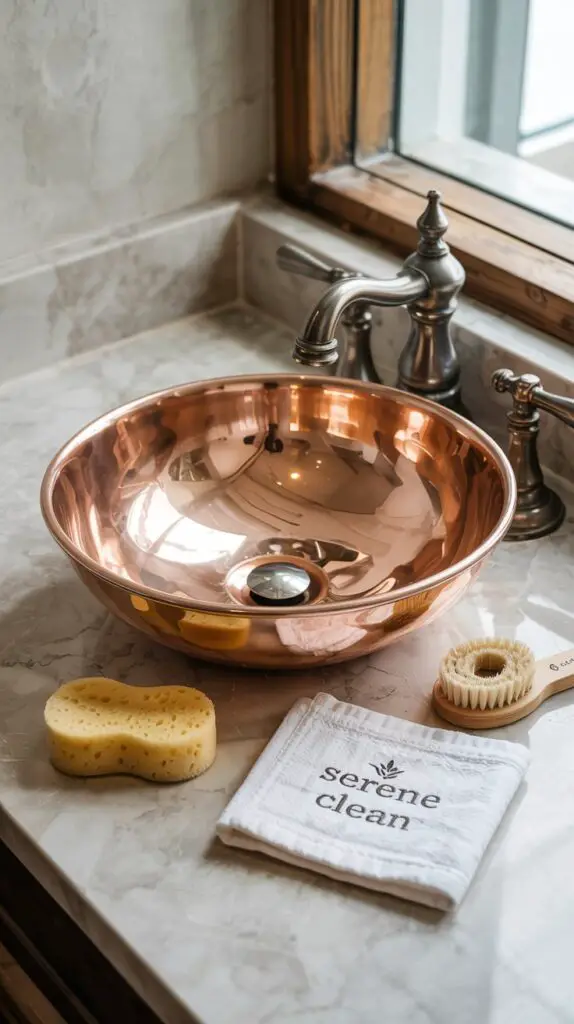
When cleaning vessel sinks, use soft sponges or cloths. Abrasive tools can scratch the surface, making your sink look worn over time.
To keep your vessel sink looking great, avoid harsh cleaning tools. A gentle touch with a soft cloth maintains its condition.
Scratches from abrasive tools can ruin the sink’s appearance and make cleaning harder. Use soft materials for a scratch-free shine.
Here is our recommended Vessel Sink on Amazon
Address Stains Quickly
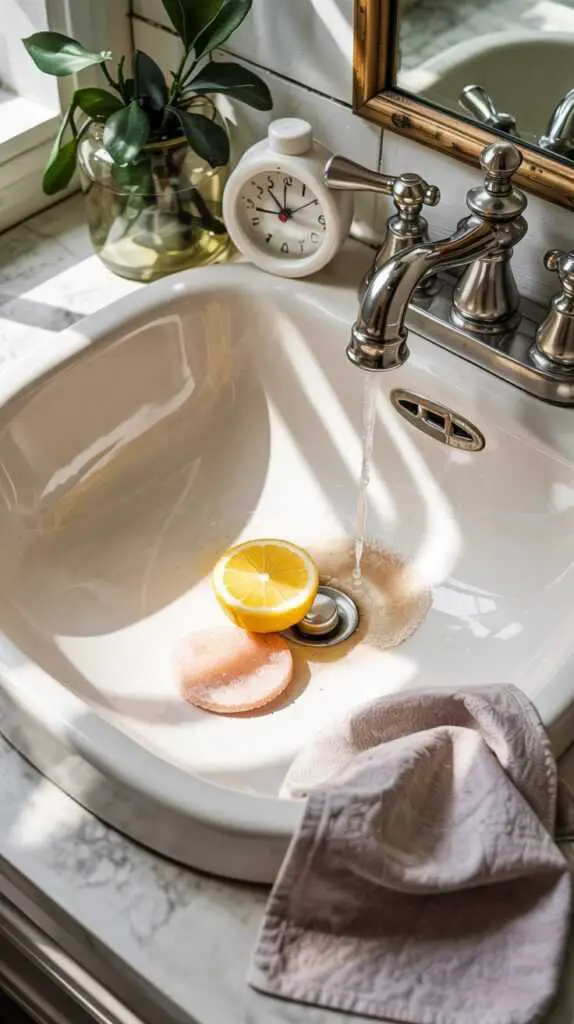
Clean any stain on your vessel sink right away. Waiting makes removal harder. Quick action helps your sink look great and prevents permanent marks.
Different substances cause different stains. For example, toothpaste and makeup can leave residues. Wipe them off immediately to stop them from sticking.
Regularly clean with gentle soap and water to prevent stains. Avoid harsh chemicals; they can damage the sink’s surface. This simple care keeps your vessel sink in top shape.
Deep Clean Periodically

Every few weeks, clean your vessel sink thoroughly. Mix baking soda and vinegar for a strong cleaner that fights tough stains and grime. This keeps your sink looking fresh.
Using this mix not only removes dirt but also eliminates odors. This natural method is safe for your sink and the environment. It’s a smart choice for regular upkeep.
Regular deep cleaning prevents residue buildup that causes discoloration. With just baking soda and vinegar, you can maintain your sink’s appearance and functionality over time.
Here is our recommended Vessel Sink on Amazon
Check for Leaks

Regularly check your plumbing for leaks or drips. Even small leaks can lead to big problems, like water damage or mold. Finding these issues early saves you time and money on repairs.
Watch for unusual sounds or damp spots around your vessel sink. These may signal hidden leaks. Detecting them early helps prevent bigger issues and keeps your sink clean and functional.
Also, inspect the seals and connections around your vessel sink. Worn seals can cause slow leaks. Replacing them when necessary keeps your sink in good shape and prevents water damage.
Seal the Sink
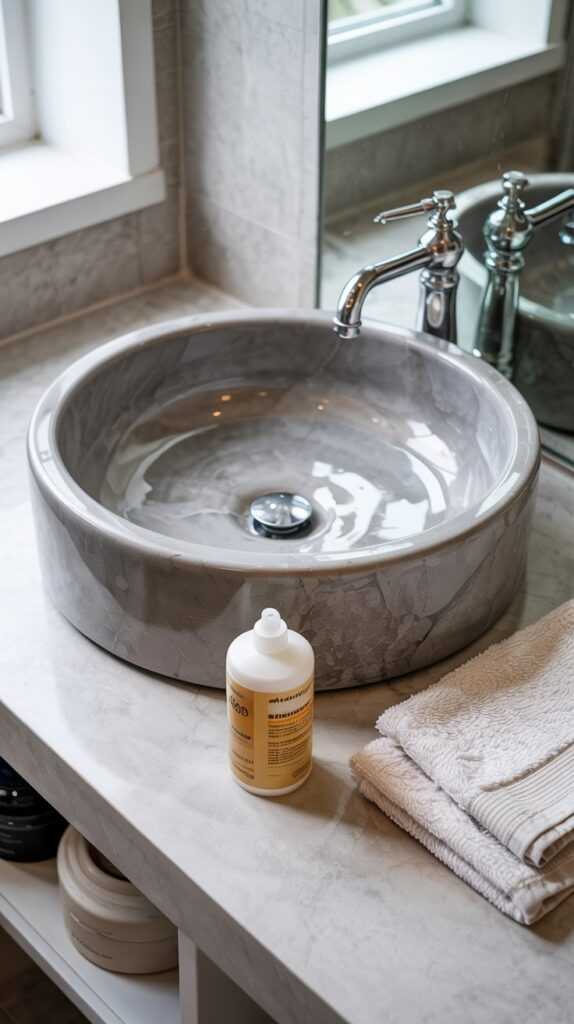
Applying a sealant on your vessel sink protects its surface and extends its lifespan. This simple step prevents stains and damage, helping your sink stay new longer.
Check the manufacturer’s guidelines to see if sealing is recommended. Some materials, like natural stone, gain a lot from this added protection, keeping them in great shape.
Regular sealant application also makes cleaning your vessel sink easier. The sealant forms a barrier that repels water and grime. This reduces the need for harsh cleaners and simplifies maintenance.
Here is our recommended Vessel Sink on Amazon
Avoid Heavy Impact
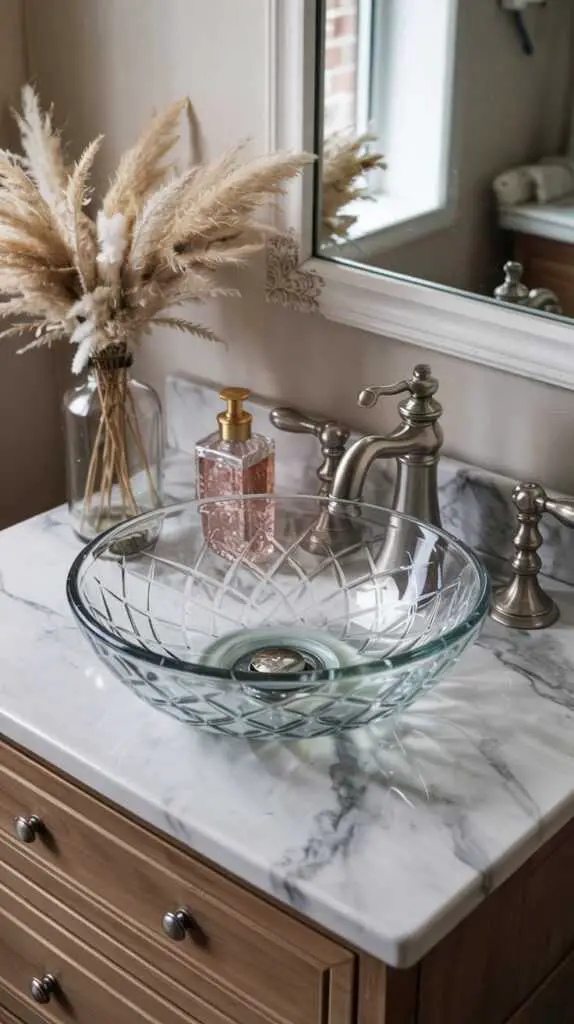
When handling heavy items near your vessel sink, always use both hands. Dropping something heavy can cause cracks or chips that are costly to fix. Support the weight properly to avoid damage.
Consider placing a cushioned mat or towel at the bottom of your sink. This precaution can absorb the impact if something slips from your hands. It helps reduce the risk of damage to the sink.
Repairing a cracked or chipped vessel sink costs time and money. To avoid this hassle, handle all items with care. Don’t place heavy objects directly into the sink. Regular maintenance keeps your sink in good shape.
Clean the Faucet

Cleaning your faucet regularly stops water spots and mineral buildup. This keeps it shiny and extends its lifespan, saving you money.
Use a gentle cleaner and a soft cloth to wipe down the faucet every few days. This simple routine prevents stains and deposits from worsening, making maintenance easier.
For tougher stains, mix vinegar and water. Apply this solution and let it sit for a few minutes. Then scrub gently. This method is affordable and effective for keeping your faucet clean.
Manage Mineral Deposits
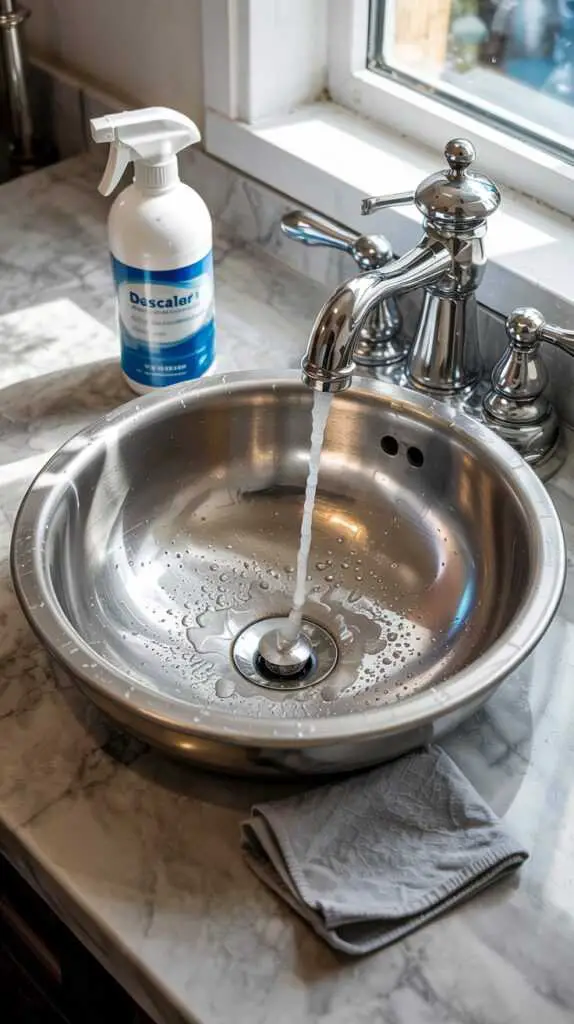
To remove mineral buildup from your sink and faucet, mix equal parts vinegar and water. Apply the solution to the affected areas. Let it sit for a few minutes, then wipe away the deposits. This method makes your sink shiny and new.
Maintaining vessel sinks requires more than just surface cleaning. Pay attention to hard-to-reach spots around the faucet and drain. A vinegar solution helps dissolve stubborn mineral deposits, keeping your sink in great shape.
For a spotless finish, soak a cloth in the vinegar solution. Wrap it around the base of the faucet and let it sit for about 10 minutes. Then scrub away the loosened deposits. This simple technique ensures a thorough clean and enhances the look of your vessel sink.
Polish Periodically
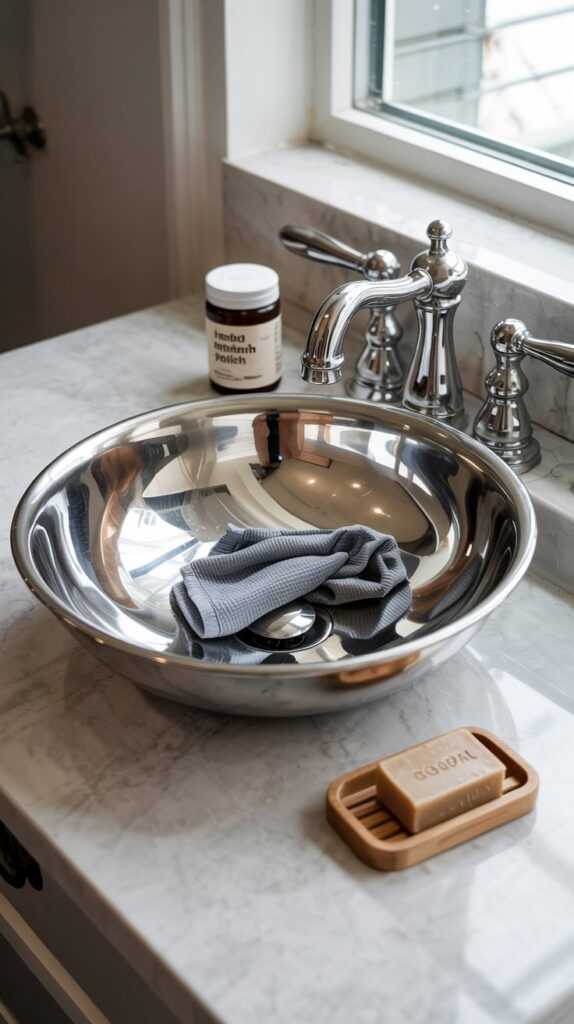
To keep your vessel sink shiny, use a good polishing product. This keeps it looking fresh and prevents dullness. Regular polishing also protects the surface from minor scratches.
Choose a polish that is safe for your sink’s material. Whether it’s stainless steel, porcelain, or glass, using the right product matters. This way, you won’t damage the sink while cleaning it.
Polish your sink every few weeks to keep it in top shape. This simple routine helps your sink look new for longer. Remember, consistent care is key to maintaining vessel sinks effectively.
Follow Manufacturer’s Instructions

To keep your vessel sink in great shape, follow the manufacturer’s care guidelines. These instructions match your sink’s material and finish, ensuring you use the right cleaning methods and products.
Regular maintenance, as suggested by the manufacturer, prevents damage and extends your sink’s life. Simple steps, like avoiding harsh chemicals and using soft cloths, help preserve its look and function.
Following the manufacturer’s instructions keeps your vessel sink looking good and maintains its warranty. This can save you from repair costs and hassles later, giving you peace of mind and lasting satisfaction.
Conclusion
Follow these 15 expert tips to keep your vessel sink beautiful and functional for years. Regular cleaning and maintenance are essential for its longevity. Add these practices to your routine for a pristine, durable sink.
What type of cleaner should I use for regular cleaning of a vessel sink?
Use a gentle cleaner for everyday cleaning. This helps remove grime and prevents buildup.
Why should I avoid using harsh chemicals on my vessel sink?
Harsh chemicals can scratch your vessel sink and ruin its finish.
What is a simple habit to prevent water spots and soap scum in my sink?
Wipe your sink after each use. This stops water spots and soap scum.
How can I prevent scratches when cleaning my vessel sink?
Use soft sponges or cloths. This way, you won’t scratch the surface.
What should I do when I see a stain on my vessel sink?
Clean the stain right away. This stops it from becoming harder to remove.
How often should I deep clean my vessel sink?
Clean your vessel sink deeply every few weeks. Use a mix of baking soda and vinegar.
Why is it important to check for leaks around my vessel sink?
Check for leaks often. This helps stop water damage and mold growth. It can save you time and money on repairs.
What is the benefit of using a sealant on a vessel sink?
Using a sealant keeps the surface safe. It stops stains and damage. Plus, it makes cleaning easier.
How can I handle heavy items near my vessel sink to avoid damage?
Always use both hands for heavy items. Also, think about putting a cushioned mat or towel at the bottom of the sink.
How can I effectively manage mineral deposits around my sink and faucet?
Mix equal parts vinegar and water. Apply it to the affected areas. Let it sit for a few minutes. Then, wipe away the deposits.

